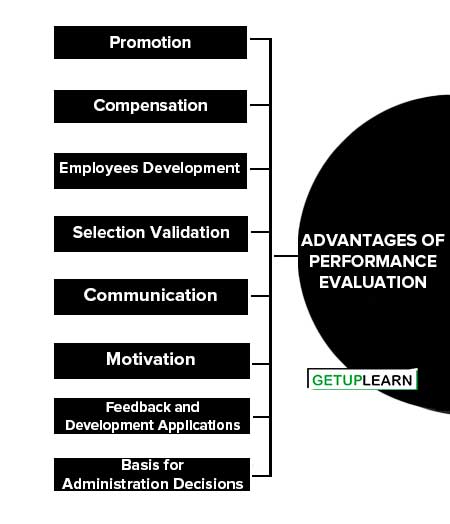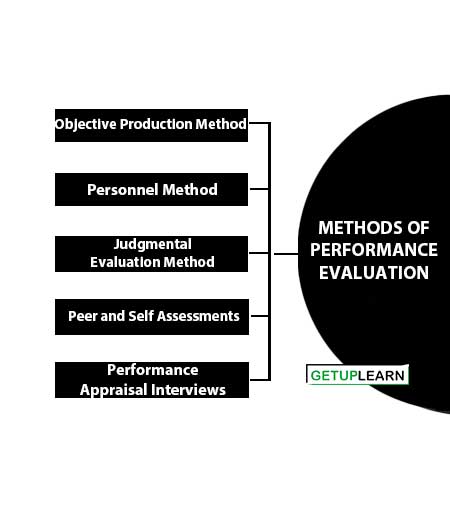Table of Contents
What is Performance Evaluation?
In simple terms, performance evaluation may be understood as the assessment of an individual’s performance in a systematic way, the performance being measured against such factors as job knowledge, quality and quantity of output, initiative, leadership abilities, supervision, dependability, cooperation, judgment, versatility, health and the alike.
Assessment should not be condensed to past performance alone. The potential of the employee for future performance must also be assessed. A performance evaluation is basically a process that not only evaluates an employee for his present performance but also helps to improve his performance in his future jobs.
The other terms used for performance evaluation are Performance rating, employee assessment, employee performance review, personnel appraisal, employee evaluation, and (perhaps the oldest of the terms used) merit rating
In a formal sense, employee assessment is as old as the concept of management, and in an informal sense, it is probably as old as mankind. Nor performance appraisal is done in isolation. It is linked to Job Analysis and Performance Standards. It describes work and translates job requirements and their relevance.
Advantages of Performance Evaluation
It is said that performance evaluation is an investment for the company which can be justified by the following advantages of performance evaluation:
- Promotion
- Compensation
- Employees Development
- Selection Validation
- Communication
- Motivation
- Feedback and Development Applications
- Basis for Administration Decisions

Promotion
Performance evaluation helps the supervisors to chalk out the promotion programs for efficient employees. In this regard, inefficient workers can be dismissed or demoted in case.
Compensation
Performance evaluation helps in chalking out compensation packages for employees. Merit rating is possible through performance evaluation. Performance evaluation tries to give worth to a performance.
Compensation packages which include bonuses, high salary rates, extra benefits, allowances, and prerequisites are dependent on performance evaluation. The criteria should be merit rather than seniority.
Employees Development
The systematic procedure of performance evaluation helps the supervisors to frame training policies and programs. It helps to analyze the strengths and weaknesses of employees so that new jobs can be designed for efficient employees. It also helps in framing future development programs.
Selection Validation
Performance evaluation helps the supervisors to understand the validity and importance of the selection procedure. The supervisors come to know the validity and thereby the strengths and weaknesses of the selection procedure. Future changes in selection methods can be made in this regard.
Communication
For an organization, effective communication between employees and employers is very important. Through performance evaluation, communication can be sought in the following ways:
- Through performance evaluation, employers can understand and accept the skills of subordinates.
- The subordinates can also understand and create trust and confidence in their superiors.
- It also helps in maintaining cordial and congenial labor-management relationships.
- It develops the spirit of work and boosts the morale of employees. All the above factors ensure effective communication.
Motivation
Performance evaluation serves as a motivational tool. Through evaluating the performance of employees, a person’s efficiency can be determined if the targets are achieved. This very well motivates a person for a better job and helps him to improve his performance in the future.
Feedback and Development Applications
Performance appraisal helps in the following:
-
Controlling the performance of subordinates
- Assessing training needs and skill gaps
- It is input to goal setting
Basis for Administration Decisions
Performance appraisal acts as the:
- Basis for pay increases based on performance
- Basis for promotions (or demotions)
- Basis for layoffs (or retention)
- Basis for work assignments
- Used for the legal defense of HR practices
Methods of Performance Evaluation
There are three main methods used to collect performance evaluation data: objective production, personnel, and judgmental evaluation. Judgmental evaluations are the most commonly used with a large variety of methods of performance evaluation:
- Objective Production Method
- Personnel Method
- Judgmental Evaluation Method
- Peer and Self Assessments
- Performance Appraisal Interviews

Objective Production Method
The objective production method consists of direct, but limited, measures such as sales figures, production numbers, the electronic performance monitoring of data entry workers, etc. The measures used to appraise performance would depend on the job and its duties.
Although these measures deal with unambiguous criteria, they are usually incomplete because of criterion contamination and criterion deficiency. Criterion contamination refers to the part of the actual criteria that is unrelated to the conceptual criteria.
Personnel Method
The personnel method is the recording of withdrawal behaviors (i.e. absenteeism, accidents). Most organizations consider unexcused absences to be indicators of poor job performance, even with all other factors being equal; however, this is subject to criterion deficiency.
The quantity of an employee’s absences does not reflect how dedicated he/she may be to the job and its duties. Especially for blue-collar jobs, accidents can often be a useful indicator of poor job performance, but this is also subject to criterion contamination because situational factors also contribute to accidents.
Once again, both types of criterion inadequacies result in reduced validity of the measure. Although excessive absenteeism and/or accidents often indicate poor job performance rather than good performance, such personnel data is not a comprehensive reflection of an employee’s performance.
Judgmental Evaluation Method
Judgmental evaluation appears to be a collection of methods, and as such, could be considered a methodology. A common approach to obtaining PAs is by means of raters. Because the raters are human, some errors will always be present in the data.
The most common types of errors are leniency errors, central tendency errors, and errors resulting from the halo effect. The halo effect is characterized by the tendency to rate a person who is exceptionally strong in one area higher than deserved in other areas.
It is the opposite of the Horns effect, where a person is rated as lower than deserved in other areas due to an extreme deficiency in a single discipline. These errors arise predominantly from social cognition and the theory that how we judge and evaluate other individuals in various contexts is associated with how we “acquire, process, and categorize information”.
Peer and Self Assessments
While assessment can be performed along reporting relationships (usually top-down), net assessment can include peer and self-assessment. Peer assessment is when assessment is performed by colleagues along both horizontal (similar function) and vertical (different function) relationships.
Self-assessments are when individuals evaluate themselves. Peer Assessments: members of a group evaluate and appraise the performance of their fellow group members. There are three common methods of peer assessments.
Peer nomination involves each group member nominating who he/she believes to be the “best” on a certain dimension of performance. Peer ratings have each group member rate each other on a set of performance dimensions. Peer ranking requires each group member to rank all fellow members from “best” to “worst” on one or more dimensions of performance.
Performance Appraisal Interviews
The performance evaluation interview is typically the final step of the appraisal process. The interview is held between the subordinate and supervisor. The performance evaluation interview can be considered of great significance to an organization’s performance evaluation system.
It is most advantageous when both the superior and subordinate participate in the interview discussion and establish goals together.
Three factors consistently contribute to effective performance evaluation interviews: the supervisor’s knowledge of the subordinate’s job and performance in it, the supervisor’s support of the subordinate, and a welcoming of the subordinate’s participation.
Problems of Performance Evaluation
Problems in Performance Evaluation are what make the task difficult for managers. Problems arise for different reasons. The important problems of performance evaluation are as follows:
- People often misunderstand the purpose: employees may see them as a form of harassment and managers may see them as a time-consuming source of grief.
- Improper system design makes the evaluations useless; involve employees in the process for greater success.
- Use of improper methods or those not based on valid, objective measurements should be avoided; the tool should evolve from a job analysis.
- Lack of evaluator training with proper follow-up is an important way to avoid problems.
- Lack of effective communication is a problem across the board. Managers need to know how to provide constructive feedback on a regular basis, not just during an evaluation.
- Subjective evaluations lead to problems like central tendency, leniency, regency effect, halo/born effect, discriminatory stereotyping, and the fear of complaints.
Opposition to Performance Evaluation
Not everyone is in favor of formal performance appraisal systems. Many employees, especially those most affected by such ratings are not very enthusiastic about them. There are many critics of these appraisals including labor unions and managers.
Labour Unions
Labor unions represent 11% (7% in the private sector) of the workforce in the United States. In some cases, they may require that seniority be taken as one of the main criteria for promotion. However, the length of job experience may not always be a reliable indication of the ability to perform a higher-level job.
That is why some employers give senior people the first opportunity for promotion, but the employer may seek to further qualify the employee for that promotion because of their abilities (not solely because of the length of service). Performance appraisals may provide a basis for the assessment of employee merit as a component of these decisions.
Managers
Managers who have had unsatisfactory experiences with inadequate or poorly designed appraisal programs may be skeptical about their usefulness.
- Some managers may not like to play the role of a judge and be responsible for the future of their subordinates.
- They may be uncomfortable about providing negative feedback to the employees.
- This tendency can lead them to inflate their assessments of the worker’s job performance, giving higher ratings than deserved.
FAQs About the Performance Evaluation
What are the advantages of performance evaluation?
The following are the advantages of performance evaluation:
1. Promotion
2. Compensation
3. Employees Development
4. Selection Validation
5. Communication
6. Motivation
7. Feedback and Development Applications
8. Basis for Administration Decisions.
What are the methods of performance evaluation?
These are the methods of performance evaluation:
1. Objective Production Method
2. Personnel Method
3. Judgmental Evaluation Method
4. Peer and Self Assessments
5. Performance Appraisal Interviews.
